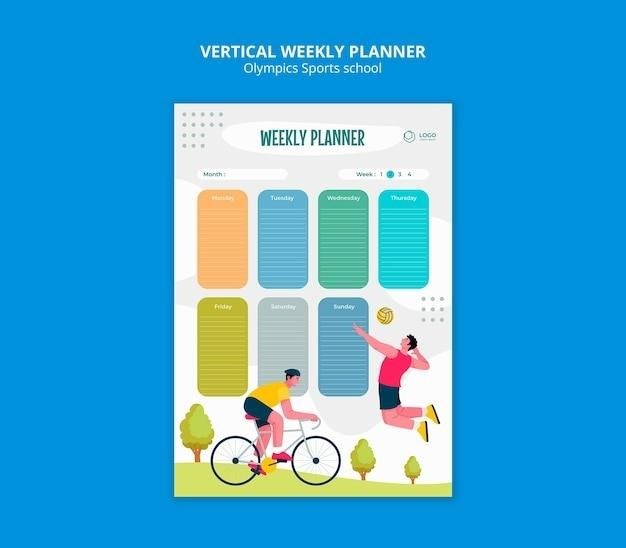Understanding Bike Frame Size
Choosing the right bike frame size is crucial for comfort, control, and overall enjoyment of your ride․ A well-fitting bike allows you to efficiently generate power, maintain good posture, and avoid strain on your joints․ This guide will walk you through the essential factors to consider when determining the perfect bike frame size for your needs․
Importance of Proper Bike Fit
A properly fitted bike is not just about comfort; it’s about performance and safety․ When your bike is the right size, you’ll experience improved pedaling efficiency, better control, and reduced strain on your body․ An ill-fitting bike can lead to discomfort, pain, and even injuries․ For example, a bike that’s too big can cause you to reach too far for the handlebars, leading to shoulder and neck strain․ A bike that’s too small can make it difficult to get enough power from your pedaling and cause knee pain․ Investing in a proper bike fit ensures you get the most out of your rides while minimizing the risk of discomfort and injury․
Types of Bikes and Sizing
Different types of bikes have varying frame size systems․ Road bikes are often sized in centimeters, with a focus on a snug fit for speed and efficiency on paved surfaces․ Mountain bikes, on the other hand, are typically sized in inches, allowing for more clearance between the rider and the top tube for safety on rough terrain․ Hybrid bikes, a blend of road and mountain bike features, often use a combination of sizing methods․ Kids’ bikes are sized based on the rider’s age and height, with smaller frames and wheels designed for younger riders․ Understanding the specific sizing conventions for each bike type is crucial for finding the perfect fit․
Key Frame Measurements
Several key measurements determine a bike frame’s size and fit․ The seat tube length, measured from the center of the bottom bracket to the top of the seat tube, is crucial for determining overall frame size․ The top tube length, measured horizontally from the head tube to the seat tube, influences reach and overall rider position․ Stack, the vertical distance from the bottom bracket to the top of the head tube, affects handlebar height and posture․ Reach, the horizontal distance from the bottom bracket to the head tube, influences how stretched or compact the rider’s position feels․ Understanding these measurements helps you compare different bike models and find a frame that aligns with your body dimensions and riding style․
Determining Your Bike Frame Size
Once you understand key frame measurements, you can determine your ideal bike frame size through a combination of inseam measurement, bike size charts, and consideration of your riding style․
Measuring Your Inseam
Your inseam is a crucial measurement for determining bike frame size․ It represents the distance from your crotch to the floor when standing straight with your feet together․ To accurately measure your inseam, stand against a wall with your feet together and a book or ruler between your legs․ The inseam is the distance from the floor to the top of the book․ You can also use a measuring tape to measure the distance from your crotch to the floor․ Once you have your inseam measurement, you can use it to determine your ideal bike frame size by consulting a bike size chart․
Using a Bike Size Chart
Bike size charts are invaluable tools for finding the right frame size․ They typically provide a range of recommended frame sizes based on rider height and inseam․ You can find size charts specifically for different bike types, such as road bikes, mountain bikes, and hybrid bikes․ When using a size chart, remember that it’s just a guide, and you may need to adjust the recommended size based on your individual riding style and preferences․ For instance, if you prefer a more upright riding position, you might choose a slightly larger frame․ If you are between sizes, it’s best to err on the side of a slightly smaller frame for a more responsive and agile feel․
Considering Your Riding Style
Your riding style plays a significant role in determining the ideal frame size․ If you are primarily a recreational rider, you may prefer a more relaxed riding position with a slightly larger frame․ This allows for greater comfort on longer rides․ However, if you are a competitive cyclist or enjoy aggressive riding, a smaller frame may be preferable․ It provides a more responsive and efficient feel, allowing you to power through climbs and navigate corners with ease․ Ultimately, the best way to find the perfect fit is to test ride different frame sizes and see which one feels most comfortable and allows you to ride in your preferred style․
Bike Frame Size Charts
Bike frame size charts provide a helpful starting point for determining the appropriate frame size for your height and inseam․ These charts typically list recommended frame sizes for different bike types, such as road, mountain, hybrid, and kids’ bikes․
Road Bikes
Road bike frame sizes are typically measured in centimeters (cm) and are designed for a more aggressive, forward-leaning riding position․ This allows for greater aerodynamic efficiency and power transfer, ideal for speed and endurance riding․ When using a road bike size chart, consider factors like your height, inseam, and riding style․ For instance, a taller rider with a longer inseam will likely need a larger frame size to achieve a comfortable and efficient riding position․ However, if you prefer a more upright riding position, you might choose a slightly smaller frame size․ It’s essential to remember that these charts are general guidelines, and it’s always best to test ride a few different sizes to find the perfect fit for your individual needs․
Mountain Bikes
Mountain bike frame sizes are usually measured in inches and cater to a more upright riding position, providing better visibility and control on rugged terrain․ When choosing a mountain bike frame size, consider your height, inseam, and riding style․ A taller rider with a longer inseam will likely need a larger frame size, while a shorter rider with a shorter inseam may be more comfortable on a smaller frame․ However, aggressive riders who prefer a more forward-leaning position might opt for a smaller size․ Additionally, the type of mountain biking you plan to do, such as cross-country or downhill, can influence your frame size choice․ It’s crucial to test ride different sizes to ensure a comfortable and efficient fit for your individual needs and riding style․
Hybrid Bikes
Hybrid bikes, designed for a blend of comfort and performance, offer a more upright riding position compared to road bikes, making them suitable for a variety of terrains and riding styles․ Frame sizes for hybrid bikes are typically measured in centimeters, providing a more precise fit․ When determining your hybrid bike frame size, consider factors such as your height, inseam, and riding style․ A taller rider with a longer inseam will likely need a larger frame size, while a shorter rider with a shorter inseam might be more comfortable on a smaller frame․ However, if you prioritize comfort and a more relaxed riding experience, you might consider opting for a slightly larger frame size․ Ultimately, the best way to find your perfect fit is by test riding different sizes and choosing the one that feels most comfortable and allows you to ride efficiently and comfortably․
Kids Bikes
Choosing the right size bike for your child is crucial for their safety and enjoyment․ Kids’ bikes are typically sized based on wheel size, with smaller wheels for younger children and larger wheels for older children․ A good rule of thumb is to choose a bike with wheels that are approximately 2-3 inches smaller than the child’s height․ For example, a child who is 4 feet tall might be comfortable on a 16-inch wheel bike․ However, it’s essential to consider the child’s individual proportions and riding ability․ A taller child with longer legs might need a larger wheel size, while a shorter child with shorter legs might be comfortable on a smaller wheel size․ Test riding a few different sizes is recommended to ensure the best fit for your child’s needs․

Additional Factors to Consider
Beyond frame size, several other factors influence bike fit and comfort․ These include bike brand and model variations, saddle height adjustment, and stem length․
Bike Brand and Model Variations
While frame size charts provide a general guideline, it’s crucial to remember that bike brands and models can have unique geometries․ Each manufacturer designs their frames with specific riding styles and performance goals in mind, leading to variations in reach, stack, and other key measurements․ Therefore, it’s essential to consult the specific size charts and geometry information provided by the bike manufacturer for the model you are considering․ Don’t rely solely on generic charts, as they may not accurately reflect the actual fit of a particular bike․
Adjusting Saddle Height and Stem Length
Even with the right frame size, fine-tuning your bike fit is essential․ Adjusting the saddle height allows you to achieve the correct leg extension and power transfer․ A properly positioned saddle should allow your leg to be fully extended at the bottom of the pedal stroke without excessive strain․ Stem length impacts your reach and handlebar position, influencing your comfort and control․ A longer stem can make the bike feel more stretched out, while a shorter stem provides a more upright riding position․ Experimenting with these adjustments can help you find the perfect balance for your riding style and body․
Professional Bike Fit
For a truly customized fit that maximizes performance and comfort, consider seeking a professional bike fit․ A certified bike fitter will use specialized tools and techniques to analyze your body dimensions, riding style, and bike geometry․ They can adjust your saddle height, stem length, handlebar position, and other components to create a precise fit that optimizes your efficiency, power, and comfort․ A professional bike fit can help prevent injuries, improve your riding experience, and ensure you’re getting the most out of your cycling adventures․
Finding the right bike frame size is a key step towards enjoying a comfortable, efficient, and safe cycling experience․
Finding the Perfect Fit
The right bike frame size allows for a comfortable and efficient riding experience․ A bike that’s too big will feel awkward and make it difficult to generate power․ Conversely, a bike that’s too small can cause discomfort and strain on your joints․ Remember, the ideal size is not a one-size-fits-all approach․ It’s essential to consider your height, inseam, riding style, and the specific type of bike you’re looking for․ By following the steps outlined in this guide, you can confidently choose a bike frame size that’s perfect for your unique needs․
Enjoy Your Ride
Once you’ve found the perfect bike frame size, it’s time to hit the road and enjoy the ride! A properly sized bike will feel natural and comfortable, allowing you to focus on the joy of cycling․ Whether you’re cruising through the park, tackling challenging trails, or commuting to work, a well-fitting bike will enhance your experience․ Remember, cycling is a rewarding activity that offers numerous health benefits, so embrace the freedom and enjoyment that comes with a bike that’s perfectly sized for you․
